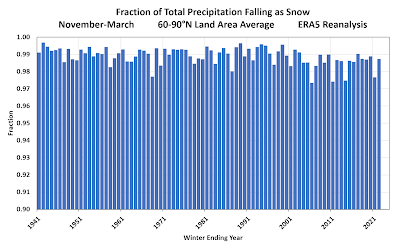It's only been 3 weeks since I wrote about back-to-back blizzards in Kotzebue that led to a local disaster declaration (news link courtesy of reader Gary), but another major storm affected the area last weekend. Remarkably, hurricane-force wind gusts were reported by the airport ASOS, although the observations were missing for several hours, so perhaps the instruments malfunctioned.
By my count, this makes five real blizzards in Kotzebue this winter: November 7, December 10-11, February 21-23, March 4, and March 25. Each of these had sustained winds above 40mph. There was also a storm on January 27-28 that briefly met the blizzard criteria (35mph wind and 1/4 mile visibility).
In light of the recurrent storminess in Kotzebue, reader Andy's recent comment about Nome being "inundated with snow in many recent winters" is very interesting and worth a closer look. Let's have a look at November-March precipitation for the two sites: the charts below show results both from the standard climate observations and from the nearest grid cell in the ERA5 reanalysis.
The large wet bias in the ERA5 data is not unexpected in model data, and it's not generally regarded as a problem - the user just has to implement a bias correction. Much more importantly, the year-to-year correlation between ERA5 and the ground truth data is fairly good back to about the mid-1970s, giving us some confidence in both sources for the last several decades. (The ERA5 does not use precipitation observations in creating its global gridded estimates.)
Excluding pre-1980 data, there's little trend in Nome winter precipitation, although the two very wet winters of 2017-18 and 2018-19 certainly count as being "inundated". At Kotzebue, however, there does seem to be a significant trend towards wetter winters in both the ERA5 and ground-truth data, and the absence of a "dry" winter since 2016-17 is notable.
As for the earlier decades, the situation is more uncertain. The Nome precipitation data doesn't seem to have enough year-to-year variability in the 50s and 60s. The correlation with ERA5 is poor in the early decades for both sites, although that by itself doesn't invalidate the climate observations, as the ERA5 uncertainties are much greater for that time. The pre-1970 numbers from Kotzebue are so low that they seem unreasonable at first glance, but if indeed the winter climate was more truly Arctic back then, then perhaps much lower precipitation is plausible. Utqiaġvik averages less than 2 inches total precipitation in November through March even after becoming much wetter in recent years.
So much for precipitation; but how about high winds (the "blizzard" aspect of the problem)?
We don't have consistent wind measurements across the decades, so I again turned to ERA5 and extracted the hourly wind speed back to 1950 for both sites. I determined the peak wind speed for each winter (November-March), calculated the median of those numbers, and then found the number of hours each winter that exceeded that "typical winter maximum". The ERA5 winds are a bit lower than reported by the ASOS instrument of today, and in reality this "typical winter maximum" corresponds to sustained winds of about 40mph in Nome and 50mph in Kotzebue. Half of all winters see winds of at least this strength at some point.
To bolster confidence that ERA5 winds are realistic, I checked the highest values in the history. The highest ERA5 hourly wind speed for Nome was at 9pm on December 28, 2021, and indeed that day saw a major wind storm that peaked at 8:30pm. In Kotzebue, the highest ERA5 wind speed in recent decades was at 11pm on February 18, 2006, and the observed wind speed peaked at the very same hour.
It's interesting that both sites have seen an increased frequency of winters with relatively high winds in the past 20 years; there have been few winters without high wind, especially at Kotzebue.
As for the maximum winds each winter, there's a hint of an upward trend in recent year for Nome, with few recent winters on the low side of the distribution, and the change seems a bit more pronounced at Kotzebue - see below.
Finally, looking at the number of days that met the blizzard criteria in the past 25 years (approximately the ASOS era), there's again perhaps just a hint of an increase in Nome, and Kotzebue has had 9 or more blizzard days in 5 of the last 6 winters.
All in all, it does seem that a trend is emerging at Kotzebue, although as usual the year-to-year variability makes it difficult to be sure, and formal significance testing would likely not give a resounding message. The trends at Nome seem more tentative and uncertain. Remind me to take another look at this a few years from now...














































